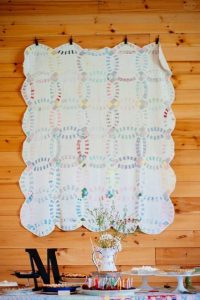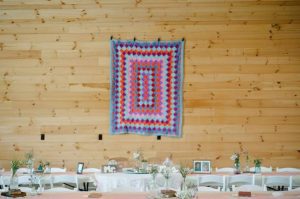For as long as I can remember, I have rested peacefully under the warm soft covers of a handmade pieced quilt. My mother and grandmothers quilted and I took for granted how nice it was to have it there on the bed during the winter. I never gave much thought to the time and effort it took to put a quilt together until I tried my hand at it. The small pieces of fabric, the precise stitching that is quilting left me with a new appreciation for the skill.
Quilting has been around for centuries and did not originate in Appalachia. However, sewing and quilting in the Appalachian mountains was just as important as livestock and farming to sustain the home. Our mothers and grandmothers learned to quilt from their mothers and made lovely quilts with the material they had.
 Putting up a quilt has changed in the last one hundred years. Our mothers before us cut out the pieces of material and then often hand stitched them together if they didn’t have a treadle machine. Once together, they either quilted or tacked the layers together. Appalachian women made most quilts totally for utilitarian use. They used every scrap of fabric they had, from old clothing to feed sack material. In later years, women made use of the nearby textile industry and got the factory’s second rated material from there. Some of these quilts were Crazy quilts, having no real pattern at all. Women made use of what they had and used every scrap and every piece. Patterned quilts were made, such as; the Star, the Drunkard’s Path, Trip Around the World, and The Wedding Ring. Appalachian women of yesteryear didn’t have the measuring mats, the cutters, the templates and the precut “fat squares” we can now buy at the local fabric store.
Putting up a quilt has changed in the last one hundred years. Our mothers before us cut out the pieces of material and then often hand stitched them together if they didn’t have a treadle machine. Once together, they either quilted or tacked the layers together. Appalachian women made most quilts totally for utilitarian use. They used every scrap of fabric they had, from old clothing to feed sack material. In later years, women made use of the nearby textile industry and got the factory’s second rated material from there. Some of these quilts were Crazy quilts, having no real pattern at all. Women made use of what they had and used every scrap and every piece. Patterned quilts were made, such as; the Star, the Drunkard’s Path, Trip Around the World, and The Wedding Ring. Appalachian women of yesteryear didn’t have the measuring mats, the cutters, the templates and the precut “fat squares” we can now buy at the local fabric store.
Quilting frames were also popular in the early Appalachian home.. Ladies would have quilting bees where they would get together and make a few quilts in no time flat, just in time for the winter season to hit. This gave the women a time to socialize, sing and have a good time while working together. Sometimes the quilt was made as a wedding gift or a going away gift. The old saying is that if an unmarried girl sleeps under a newly made quilt, she will dream of the man she is to marry.
 One of my earliest memories was that of my mom putting up a quilt. I remember her cutting apart a Kellogg’s cornflake box to use the card board to measure the size square she needed. She would cut a few from the box and use that as a template to cut the cloth. The cloth was various colors of material she had in a big box in the closet. She had an old treadle sewing machine that she used to sew the squares together. When she was done piecing the quilt top, she found two huge pieces of cloth, and sewed it together for the backing. Having moved the furniture and coffee table, she spread the backing out on the floor, then the batting, then the quilt top. She would then hand sew big sloppy stitches around the sides to hold it together. After that was done she would roll it up, lay it on the couch and begin tacking it together. My mother wasn’t one for quilting; too time consuming and unnecessary in her opinion. These were going to be working quilts, not Sunday bed quilts. So she would sit there in a straight backed chair, sewing knots in the quilt with heavy string or yarn, going back and forth along the length of the quilt. I was the lucky one who got to cut the strings into tassles. It turned out beautiful.
One of my earliest memories was that of my mom putting up a quilt. I remember her cutting apart a Kellogg’s cornflake box to use the card board to measure the size square she needed. She would cut a few from the box and use that as a template to cut the cloth. The cloth was various colors of material she had in a big box in the closet. She had an old treadle sewing machine that she used to sew the squares together. When she was done piecing the quilt top, she found two huge pieces of cloth, and sewed it together for the backing. Having moved the furniture and coffee table, she spread the backing out on the floor, then the batting, then the quilt top. She would then hand sew big sloppy stitches around the sides to hold it together. After that was done she would roll it up, lay it on the couch and begin tacking it together. My mother wasn’t one for quilting; too time consuming and unnecessary in her opinion. These were going to be working quilts, not Sunday bed quilts. So she would sit there in a straight backed chair, sewing knots in the quilt with heavy string or yarn, going back and forth along the length of the quilt. I was the lucky one who got to cut the strings into tassles. It turned out beautiful.
With the ease of buying machine-made store bought blankets, quilting for necessity has been replaced and quilting has now became an art form. Quilt fairs and quilting clubs display machine-quilted covers with intricate stitching and piece work. We now have barn quilts on our buildings. Family quilts warm the body and the senses, holding memories of the loved ones who unknowingly put together such a wonderful family heirloom to be cherished.

